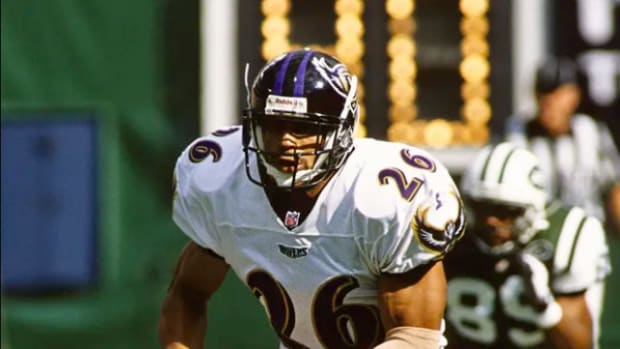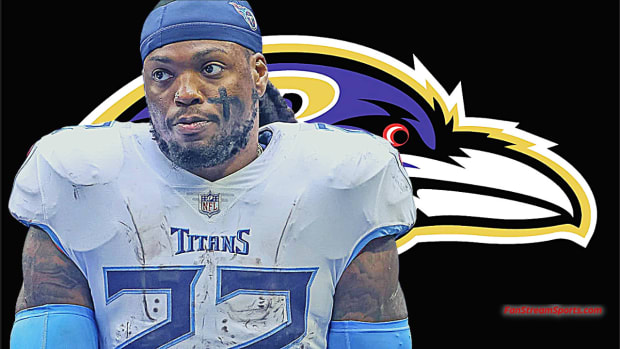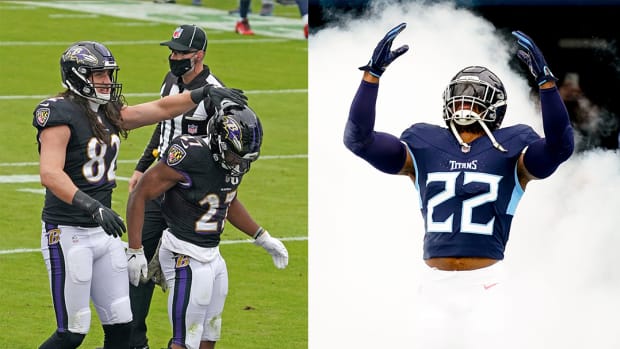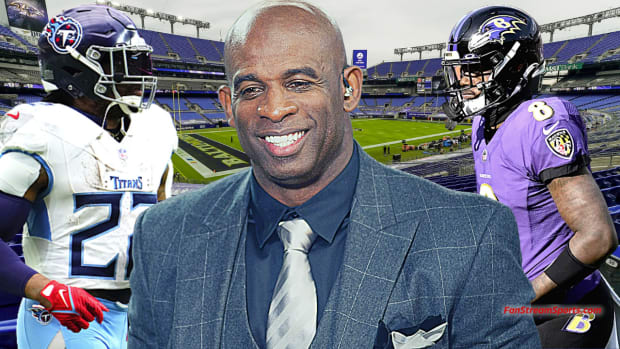Petrino: How Lamar Jackson Has Transformed NFL Quarterbacking
Late in the Baltimore Ravens’ 49-13 rout of the Cincinnati Bengals on Nov. 10, 2019, Ravens coach John Harbaugh approached his quarterback, Lamar Jackson, who was seated on the bench.
It had been another brilliant performance by the second-year QB, who a few months later would be a unanimous choice as the NFL’s MVP: 15-for-17 passing for 223 yards and three touchdowns, along with 65 yards and another TD on seven rushing attempts.
But that wasn’t all that was on Harbaugh’s mind as he congratulated Jackson. First he praised his relentlessness, which, he assured his QB, resonated with his teammates. Then Harbaugh considered the big picture.
“You changed the game, man,” he told Jackson. “You know how many little kids in this country are going to be wearing No. 8 (Jackson’s number) playing quarterback the next 20 years?”
The Ravens finished the regular season with a 14-2 record and won the AFC North. And while they were upset by the Tennessee Titans in the first round of the playoffs, that did little to diminish Jackson’s accomplishments. He threw for 3,127 yards and a league-leading 36 touchdowns, while being intercepted just six times. He also ran for 1,206 yards, most ever by a quarterback, and seven scores.
At age 23 he became the youngest QB to be named MVP, and the second-youngest player in league history. (Only long-retired Cleveland running back Jim Brown, who earned the award at ages 21 and 22, was younger.) Jackson, who also opened the 2020 season with a strong game against Cleveland, was also the first Raven to win the award, and joined New England’s Tom Brady (2010) as the only unanimous choices.
One of the voters was CBS broadcaster Rich Gannon, a former NFL quarterback. He told the Baltimore Sun that Jackson is “unique” and possessing of “a very special skill set” while adding:
“On top of that, he brings toughness and competitiveness that is way up there when you start to evaluate young quarterbacks. … (T)he numbers are significant, but what I look for is consistency, and he played at a really high level throughout the course of the regular season. I thought he was the best player in the regular season, and by a lot.”
While 2020 hasn’t unfolded in quite the same fashion as last season, it’s gratifying for me to see how Lamar’s career has unfolded. It’s not the least bit surprising, though, given all the hard work he put in when he played for me at the University of Louisville. He was rewarded with the Heisman Trophy in 2016, and deservedly so. Every week brought a new set of highlights, another can-you-believe-this stat line.
While there were few questions about Lamar’s running ability entering the 2018 NFL draft, some scouts wondered if he would be a good enough passer to succeed at the pro level. There were even suggestions that he might be better-suited for another position, like running back.
I give the Ravens a lot of credit, though. They did their due diligence. They met with me and my staff. They knew exactly what they were getting with Lamar. Even so, they didn’t use their initial first-round pick, No. 25 overall, on him; they took tight end Hayden Hurst (now with the Atlanta Falcons) in that spot. But Baltimore later engineered a trade for the 30th and final selection of the first round, and grabbed Lamar there.
In other words, every other team in the league could have had him. It’s the ultimate second guess, the ultimate what-might-have-been, ranking up there with the 2005 draft, when another QB, surefire Hall of Famer Aaron Rodgers, fell to the Green Bay Packers at No. 24.
Truth be told, it hadn’t been too many years earlier when I had some questions of my own about Lamar, as he was coming out of Boynton Beach (Fla.) High School. One of my assistant coaches, Lamar Thomas, told me Lamar was interested in coming to Louisville, so I began looking at some video. His athletic ability was immediately apparent, but so too was his arm. I like to joke that we broke a rule in signing him -- a self-imposed rule about never offering a quarterback a scholarship until we saw him live. I had always thought that was the only way to truly gauge a QB’s ability.
I learned soon enough. And on the very first day of preseason drills in 2015, I was standing alongside athletic director Tom Jurich as Jackson broke the huddle with his teammates.
“Watch this guy throw the ball,” I told Tom.
And sure enough, Lamar snapped his wrist and whistled a touchdown pass to one of our receivers.
Jackson’s ability was such that we decided to play him immediately, but only in certain situations. We gave him a small package of plays that suited his playing style, one of them a trick play we used on the opening snap of our opener at Auburn.
That didn’t work out so well. Lamar, who lined up at running back and threw an option pass, was intercepted.
He did, however, rush for 106 yards in a loss to the powerful Tigers, and continued to progress as his freshman season unfolded. Every day he worked harder than everybody else in practice, which is an ideal situation for a coach: If your best player always gives maximum effort, that sets a tremendous tone for the rest of the squad.
Lamar wound up starting eight games for us that season, none better than the Music City Bowl against Texas A&M, a 27-21 victory in which he accounted for all four of our touchdowns -- two through the air and two on the ground. In all he amassed 227 yards passing and 226 rushing, and was named the game’s MVP.
That served as a springboard for the 2016 season, when Lamar threw for 3,543 yards and 30 touchdowns, and ran for 1,571 yards and 21 scores en route to the Heisman.
The very first week, against overmatched Charlotte, he threw for six touchdowns and ran for two in just the first half. The week after that, at Syracuse, he fired a 72-yard TD pass on the game’s first play, hurdled a defender while running for a score and accumulated an astounding 610 yards total offense -- 411 through the air and 199 on the ground. And the week after that he engineered an upset of second-ranked Florida State by running for four touchdowns and passing for another.
His other landmark game was a loss at No. 5 Clemson in which he generated 357 yards total offense.
In all Lamar had 10 games in which he threw for 200 yards or more and eight in which he ran for 100 or more. He became the first major college player to pass for over 3,300 yards and rush for over 1,500 in the same season, and was presented the Heisman 28 days short of his 20th birthday, making him the youngest winner of that award.
He enjoyed another productive season in 2017. Then it was on to the Ravens. And now he appears headed to untold heights, perhaps changing the game in the process.
— Bobby Petrino, hired at Missouri State in January, is in his 16th year as a head coach, and his 37th year in the profession. His most notable stops were at the University of Louisville (2003-06 and 2014-18) and the University of Arkansas (2008-11). He has compiled a 119-59 collegiate record and seen his teams finish in the Top 25 seven times, including Top 10 showings at Louisville in 2004 and 2006 and at Arkansas in 2011. His teams have also played in 11 bowl games, winning five.




